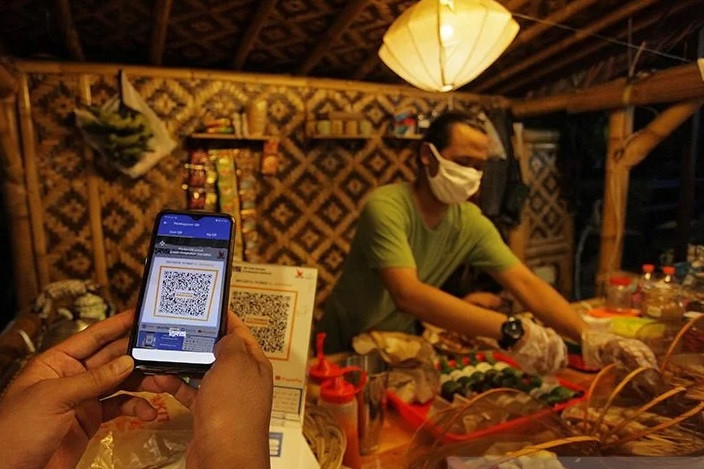Popular Reads
Top Results
Can't find what you're looking for?
View all search resultsPopular Reads
Top Results
Can't find what you're looking for?
View all search resultsQRIS: The end for e-wallets?
It is safe to assume that the QRIS system, having grown over the years both in usage and features, will assume an increasingly dominant role in digital payments.
Change text size
Gift Premium Articles
to Anyone
 A buyer pays his bill using Quick Response Indonesia Standard (QRIS) code at a street foodstall on Jl. Ampera Raya in South Jakarta on Feb. 6, 2021. Bank Indonesia estimated 12 million micro, small and medium enterprises (MSMEs) would shift to the cashless-payment method in 2021. (Antara/Reno Esnir)
A buyer pays his bill using Quick Response Indonesia Standard (QRIS) code at a street foodstall on Jl. Ampera Raya in South Jakarta on Feb. 6, 2021. Bank Indonesia estimated 12 million micro, small and medium enterprises (MSMEs) would shift to the cashless-payment method in 2021. (Antara/Reno Esnir)
W
hen Bank Indonesia (BI) launched its Quick Response Indonesia Standard (QRIS) in May 2019, it hailed the move as a way to bring order to an increasingly complex payments ecosystem.
“QRIS allows QR-code-facilitated payments to be interconnected and interoperable through a single standardized code,” said BI Governor Perry Warjiyo during the launch ceremony in Jakarta.
The aim is to universalize cashless payments in the country through a system that integrates all those digital payment apps people have installed on their smartphones. One code to rule them all.
BI has been pushing QRIS ever since, working with commercial banks, e-wallet providers and businesses to get ever more merchants to put up the code for customers to scan, down to the level of street vendors.
The standard is now widely in use in urban centers, though pull up at a highway rest area and you will find yourself digging into your pocket for cash (or maybe a credit card).
This newspaper has reported on Jakartans feeling overwhelmed with the multitude of payment options, often for fear of missing out on the hefty discounts offered by e-wallet providers vying for market share, particularly some years ago.
Retailers likewise expressed annoyance as the array of QR codes from OVO, GoPay, DANA, ShopeePay, LinkAja and many others claimed more and more space on sales counters and created a hassle for bookkeeping.
QRIS, which physically manifests as a more-complex QR pattern, promised to change all that by allowing users from one payment service to transfer funds to any rival service within BI’s ecosystem.
While that seems like a neat solution to the code jungle we had before, it does beg a question: Do we still need those rivaling services at all? QRIS is placed at the front end of the cashless-payment ecosystem, but it could be have major consequences for the back end.
When e-wallets burst onto the scene a couple of years ago, they revolutionized retail payments. Suddenly, we could pay within seconds just scanning a code with our phones, not to mention the incentives offered with points, cashback and whatnot. Avoiding cash came in handy during the pandemic as well.
But if BI connects ever more banks and merchants to its system, allowing for easy bank-to-bank payments between clients and vendors, e-wallet providers and private transaction gateways may find their own purpose vastly diminished.
One noteworthy difference of the QRIS system is that BI, unlike OVO, GoPay and others, charges a fee of 0.7 percent on most commercial transactions. While this will make it harder for BI to boost adoption, the rate is competitive when compared to transaction fees for credit card payments or other services, such as PayPal.
It is safe to assume that the QRIS system, having grown over the years both in usage and features, will assume an increasingly dominant role in digital payments. Where this leaves e-wallets is less certain, but technology has an element of surprise, so pronouncing its end would be premature.
For consumers and retailers, what matters most is the ability to conduct safe, fast and easy payments. QRIS is a big step in that direction, though it undoubtedly was inspired by venture-capital funded private-sector initiatives.
As the monetary authority of the country, BI has always had a fundamental role to play in financial transactions, and that holds true for digital as much as for cash transactions.
The next task for the central bank, we might suggest, is to work together with its counterparts in other ASEAN countries to simplify cross-border transactions within the region, which is a single market in the making.
The goal would be to develop a regional system that would make payments and transfers between individuals and businesses fast and secure, and as easy as scanning a QR code.










